I want to say it is actually very possible to eliminate junks completely in the Lunchbox. I don’t believe in a few days a week. Many years ago, I tried it in a period where we had healthy eating as our science topic and one of the things we immediately noticed was the noise level in the class went down dramatically- the shouting, the overexcitement, the running around.
Noyenum Emafo

I got connected to Mrs Noyenum Emafo through a dear friend of mine whose kid attends her school. She had shared with me how in December the school decided that they were going to completely eliminate junks from lunch boxes for children and they’ll only be accepting food, water and fruits and that really intrigued me. So when Lunch Box Purity series came to me i knew i wanted to get into her head to know why they were thinking that way. And now that they are few weeks down the line, it’ll be nice to see how it’s going.
So over to Mrs Noyenum Emafo
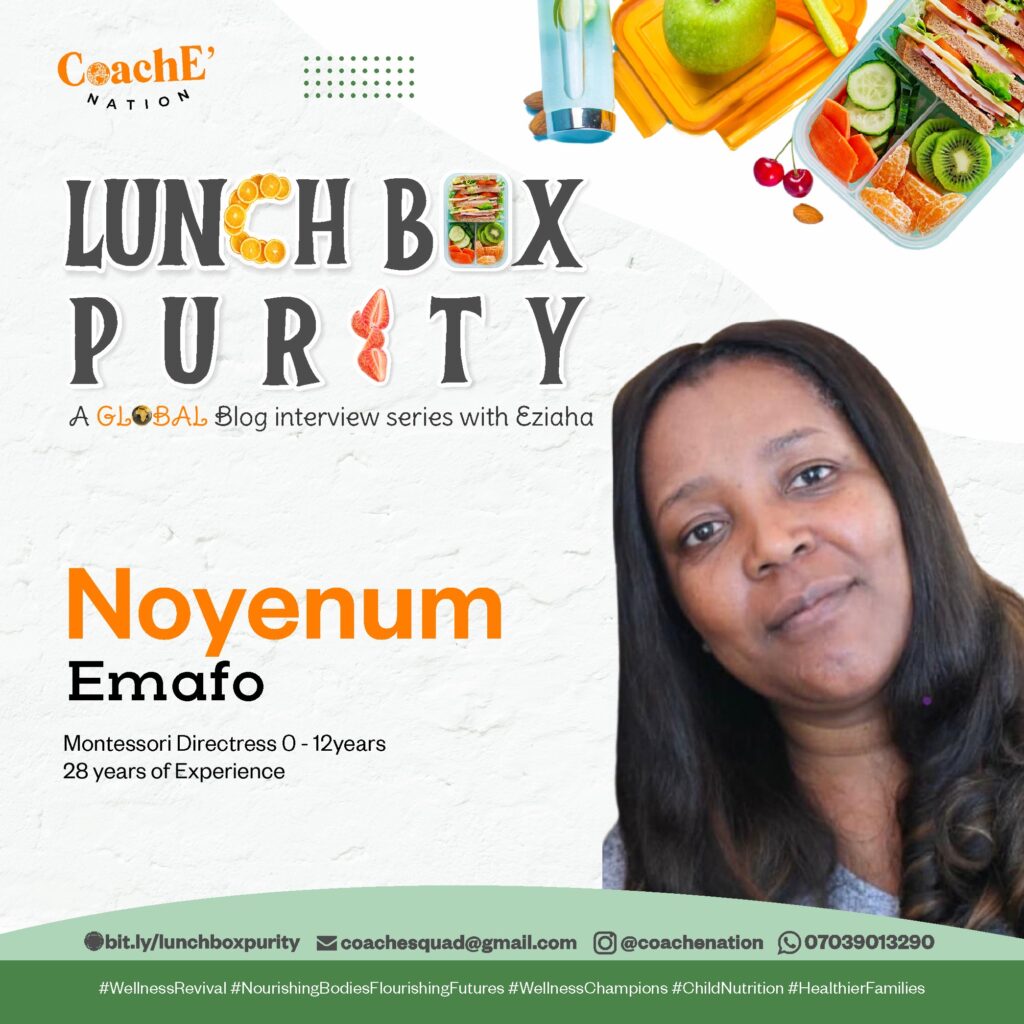
1. Please tell us your name, where you currently teach, years on the job and how you got into the beautiful world of education.
Answer
My name is Noyenum Emafo. I teach at and own Lekki Montessori School in Lekki phase 1 .I have been teaching for 28 years and I’ve had my school for 22 years. It was first a nursery and the primary started 8-9 years ago.
2. Your most significant/memorable experience as an Educator?
Answer
At the beginning of every year, we access the children. When we give the report cards at the end of the summer term and then in September we do another review of the children because sometimes they would have lost concepts that were taught in the previous year.
At the end of the year, we do another review and every single year of the 28 years I have been teaching, when we measure progress, it is amazing what you see at the end of the year. How much the children have learnt and how much they have changed. I think that’s just it.
We do that assessment in September and we put it away completely. We don’t refer to it apart from drawing up our curriculum plan until the end of the school year. It’s always like night and day. There is no child that has not changed significantly and I think that every year, those are my most precious moments. End of the year review of all of the children in the school.
What they could not do in September and what they can do now.

3. Is it actually possible for a school to eliminate completely junk in the lunch box of our children as opposed to having a few days a week where junk is not allowed? If no, why?
Answer
I want to say it is actually very possible to eliminate junks completely in the Lunchbox. I don’t believe in a few days a week. Many years ago, I tried it in a period where we had healthy eating as our science topic and one of the things we immediately noticed was the noise level in the class went down dramatically- the shouting, the over excitement, the running around. I think that was a shock to all of us and over the years of course we’ve lost track and then we came back but at the end of last school year, I am a Montessori teacher and AMI (a Montessori organization I am registered with) started a global movement for healthy eating and they asked people who wanted to subscribe and I did subscribe to it and that’s where this idea came from.
4. Have you ever been a part of a transitioning process in the school? By this, I mean where the school decides that we would have junk-free days a few times a week, or even junk-free days everyday. If yes, how was that transition process and what was the outcome like? What impact did you see in the children? And if you were to help another school transition, what are the best practices you would recommend to make it seamless?
Answer
The transition process was quite seamless. What we did was to talk to the children about it at the end of the last school year and get their buy in and the children are absolutely fantastic when it comes to buyings and as soon as they buy into it, we then started to hint the parents and during our end of school year show we announced it to the parents and told them to please get ready for it as it’s going to start in September. From September, we are not going to have anything but healthy food in the Lunchboxes and before the school resumes in our welcome letter we sent a reminder to the parents and of course, some children still came with junk foods. Ours isn’t just junk food, they are not even allowed to bring sandwiches. It’s fruits and vegetables only. The teachers as well as the children have to commit to it so it’s everybody group snack talking about what they are having today. What they like and fruits they like are just those little conversations about the food in our lunchboxes.
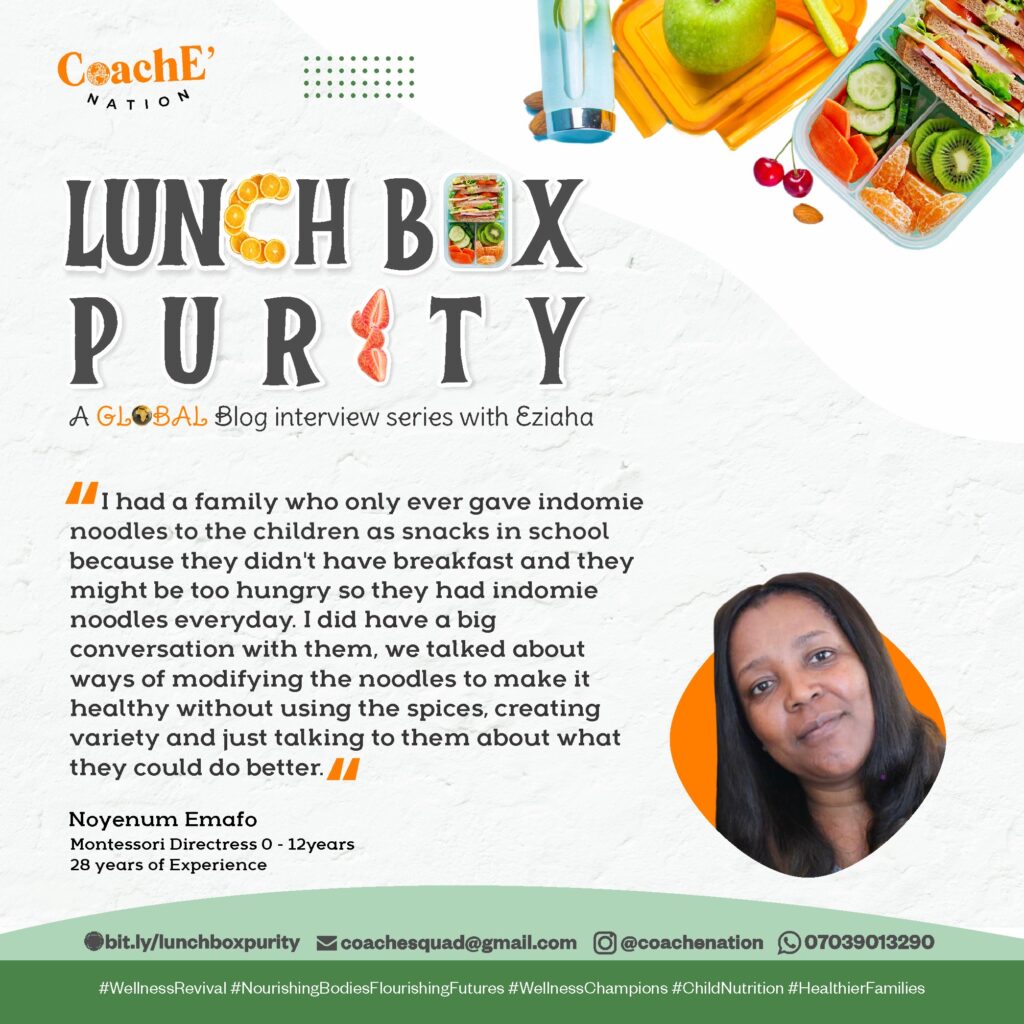
5. Are there times when an Educator (you or someone else) has had to intervene per the content of a child’s lunch box, especially when you can see that the frequency and volume can negatively impact on the child’s health both short term and especially long term? If yes, how did that go and/or how can an Educator help/intervene without coming across as being judgmental? How do we educate that child and/or the parent into better and healthier decisions?
Answer
Yes there are many times I’ve had to intervene with regards to food in the lunchbox. I had a family who only ever gave indomie noodles to the children as snacks in school because they didn’t have breakfast and they might be too hungry so they had indomie noodles everyday. I did have a big conversation with them, we talked about ways of modifying the noodles to make it healthy without using the spices, creating variety and just talking to them about what they could do better. We have had ants in the children’s lunchboxes. Parents don’t seem to realize that those lunch boxes can be washed so we occasionally have ants in the lunchboxes. (I hope the parents in my school will not be annoyed I said that)
So we often have to remind the children to wash their lunch boxes or lunch bags on Friday. We’ve also had cases of milk that have gone off, lunch boxes, food flasks that were not washed. Water bottles that were not washed and fresh water or juice or milk had been put in and gone off and yes we do speak to the parents quite nicely. We understand that everybody is busy but we then appeal to them to please look into it especially if their domestic helpers are the ones doing the work. We’ve had raw food come to school and on investigation the case was the nanny was petrified to tell the parents that the food hadn’t cooked at the time the child was leaving and because she didn’t want to be shouted at, she scooped out the chips from the oil and packed them into the lunch box. It’s just again to educate the parents very gently and politely because these things can happen to anybody and you can’t even be judgmental. I have 3 children of my own and I am sure I have made quite a few mistakes along the way as well.
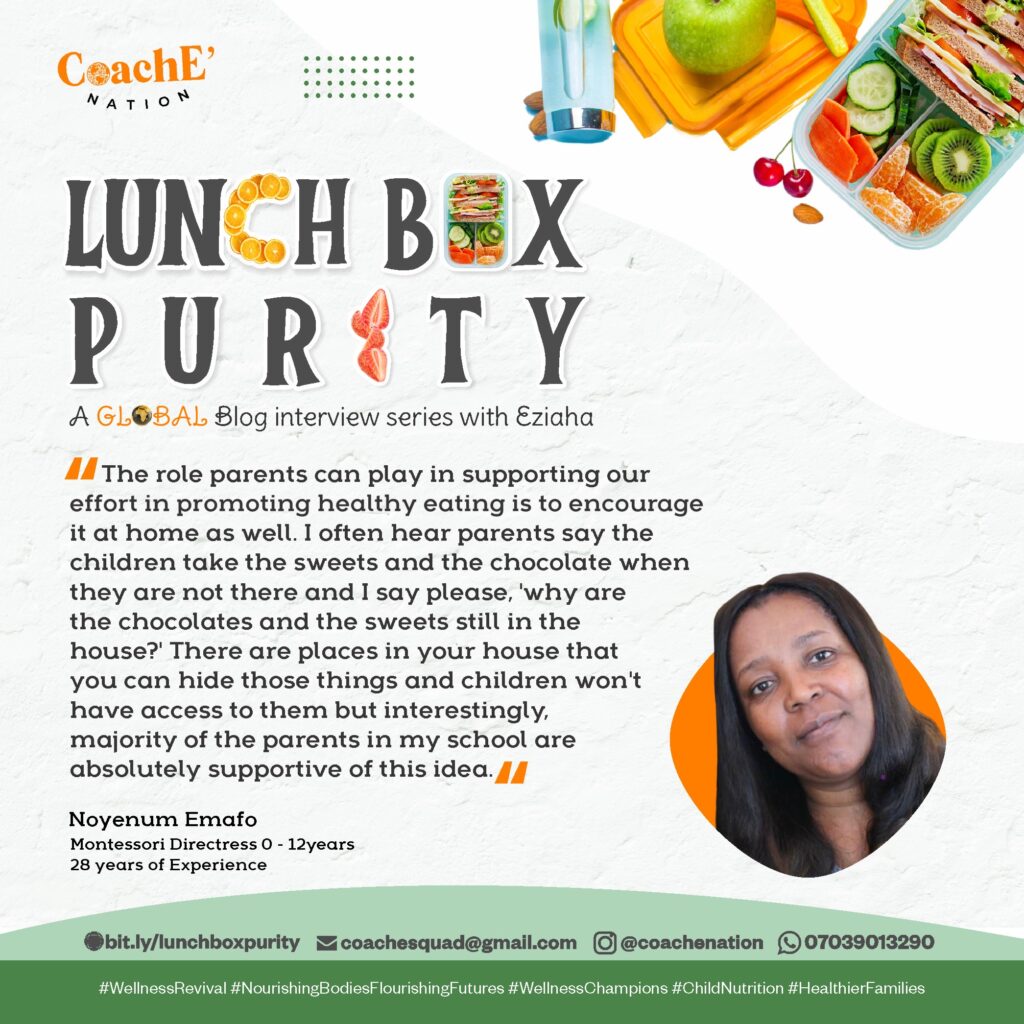
6. What role can parents play in supporting your efforts to promote healthy eating? How best should we communicate with parents about the importance of nutritious lunches? Do you have any practical success stories on this?
Answer
The role parents can play in supporting our effort in promoting healthy eating is to encourage it at home as well I often hear parents say the children take the sweets and the chocolate when they are not there and I say please why are the chocolates and the sweets still in the house and there are places in your house that you can hide those things children won’t have access to them. Interestingly, majority of the parents in my school are absolutely supportive of this idea. They’ve embraced it fully and you know we are more health conscious in our generation so they understand the importance and actually see it as a form of support.
We also advised parents and spoke to them about varieties with regards to the vegetable and the fruits they put in. So one of the things I tease the parents about when I talk to them is, please don’t buy one watermelon and cut it up for 5 days. This poor child is eating watermelon everyday in school. You can buy a variety of fruits and vegetables. You can discuss with the children what you are putting in, you could put a salad in. Because of this project, we have provided a small refrigerator in the classroom so that as the children come in they can put their snacks in the fridge.
My children when they were in school, (they didn’t attend my school as they are much older and I didn’t have a primary school then) I used to give them salad and what I usually do is to put a container of ice in that lunch box sealed tight and then the salad in a bowl as well. So there are usually two bowls, one with ice to keep it cool, the other one with the salad airtight as well so that water from the ice doesn’t pour into the salad and the salad was perfectly okay the whole day.
7. How can the Government, Federal or state, throw their weight behind schools (in terms of policies for example) in the fight to ensure that at least within schools, child nutrition is front and centre?
Answer
I don’t honestly think that the choice of what to eat or what to feed your children with should have anything to do with government policies I think that these are very individual decisions that we come to and I didn’t know that it could be imposed. I think that in some places they would say that you should always have some amount of fruits and vegetables a day but not necessarily to impose it because if you impose it on the school, without the child’s and the parent’s buy in I honestly don’t know how that will work. I think that the only thing the government can do is to advertise it, talk about its benefits and encourage people to do it. I think that this is more of an individual approach than a general one. Child nutrition of course educates us about children’s nutrition and its benefits but not necessarily an imposition. (Please let me know if I’m wrong on this, I am open to learn differently)
8. Are there ways you have successfully incorporated Nutrition education into your curriculum? Can you share any successful strategies you’ve used to make nutrition education engaging for children? This really speaks to it being incorporated into the learning curriculum as opposed to scheduled events.
Answer
Interestingly, this term we are looking at the human teeth and eye in biology. In talking about the teeth, we will look into the care of the teeth, bacteria, decays, parts of the teeth and eating healthy. Those bacteria staying in your mouth, the reason they’re staying in your mouth, how do they get in, what harm do they cause to the teeth as well as brushing your teeth, the correct way to brushing teeth, the importance of the teeth, what they do in your mouth, what happens when you lose your teeth, the process of getting a filling, the process of getting an extraction, a root canal and implants. Very painful and pleasant stories for the children to listen to and of course a visit to the dentist. When we do digestion as well we talk about the different types of food and the nervous system that are affected by what we eat, the bones are affected too as well as the heart is affected by what we eat. it’s all over our biology curriculum. Anything that has to do with biology or the human body is a fantastic avenue for nutrition. Nutrition itself could be a topic.
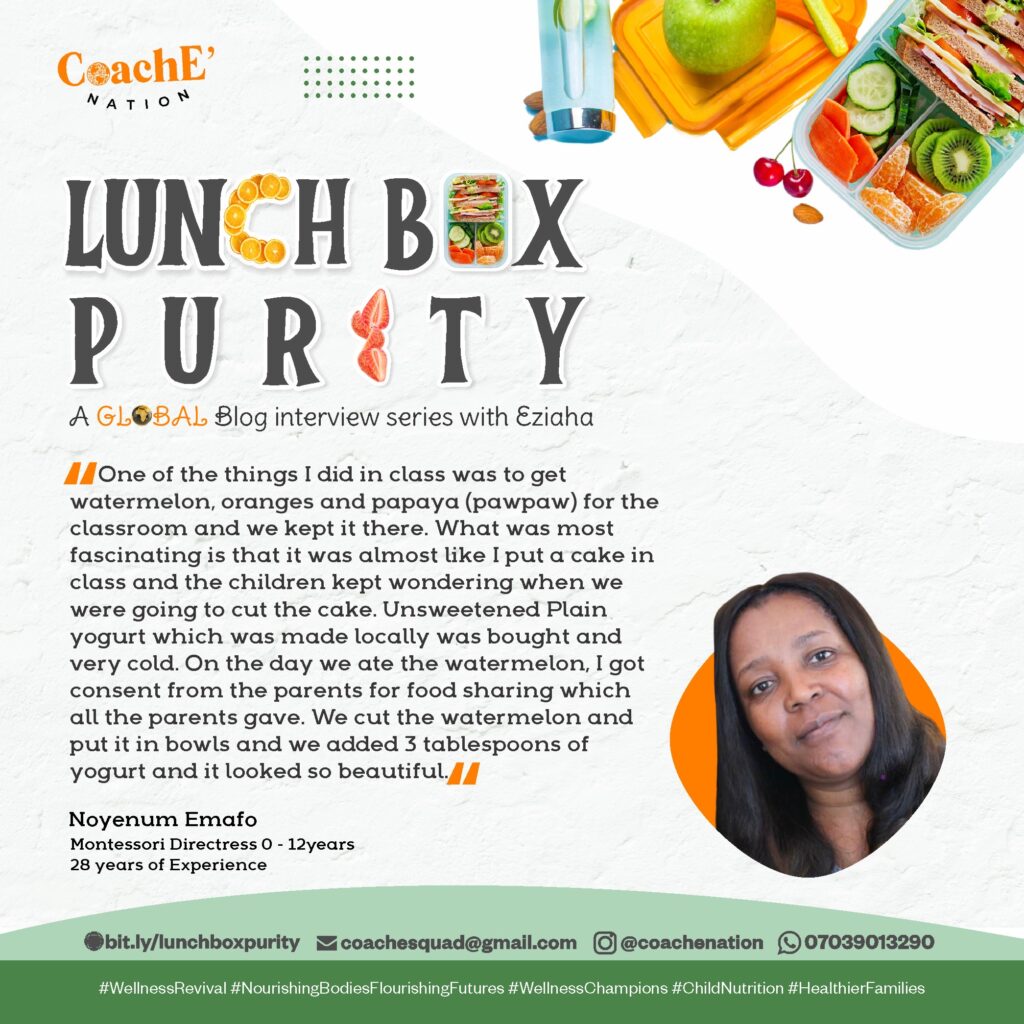
9. What Policies/Practices does your school have in place to ensure healthy eating for children while at school? What have you found to work and have you faced any challenges in implementing them? Maybe culinary or nutrition-related events? Please share memorable experiences from these if any?
Answer
I think that I didn’t impose it as a policy, I suggested that it might be a good idea. I told the parents this is what we are going to do but we will have an opportunity for a review after the half term to get a sense of what people are feeling or how the children are feeling. One of the things I think is that the children are perfectly okay with it I did have a parent who sent a message recently to ask if she could send home made popcorn as snack because she didn’t think that fruit and vegetables were just enough and the children needed fiber even grain would be helpful and corn was a grain and basically if you pop the corn then you have in something healthy. I did tell the administrator to let her know that I will look into the popcorn business but by the time you add sugar or salt to that corn you’ve changed the program completely but I’m happy to look at it and find out what the benefits are but also fiber and all these things can be given at home if you so desire.
The children in particular, especially the children of the parents who suggested popcorn, do not mind eating their fruits and vegetables; they absolutely enjoy it. They don’t have any issue with it, there’s been no drama in school and snacks are eaten as when required. I don’t think I’ve had any issue whatsoever with the children or the parents and this was just a suggestion by the parent to diversify. Sometimes of course parents have pre-bought these snacks and I’m just feeling what am I supposed to do with this and so the answer is No.
One of the things I did in class was to get watermelon, oranges and papaya (pawpaw) for the classroom and we kept it there. What was most fascinating is that it was almost like I put a cake in class and the children kept wondering when we were going to cut the cake. Unsweetened Plain yogurt which was made locally was bought and very cold. On the day we ate the watermelon, I got consent from the parents for food sharing which all the parents gave. We cut the watermelon and put it in bowls and we added 3 tablespoons of yogurt and it looked so beautiful. It did not taste as delicious as it looked in the eyes of the children but the coldness from the yogurt and just the fruit itself. Watermelon is very juicy and succulent. It made the children enjoy it. They all finished that snack so when it’s eaten as a group event then it’s obviously fun for the children.
10. Can you share any observations or experiences where improvements in a child’s diet led to noticeable changes in their behavior or academic performance?
Answer
Another thing is part of my teaching practice when I was training to become a teacher was done in India and in that school you don’t even bring cake for your birthday. You bring a bag of nuts, different kinds of nuts and so that’s how birthdays were celebrated. Children did not use plastic food containers, everything has to be metal or glass reusable so they have that recycling culture as well in India. They didn’t bring packets of biscuits or cakes, it had to be cooked food. Interestingly, the food was not refrigerated, not warmed in the microwave and the children ate it. This school was not even in a low income area so it wasn’t like poor children. They ate the food. They brought rice, sauces, naan bread they brought cooked foods and nuts and that was it and the children were happy so it’s really what we encourage them to do. It’s what we teach them that they do they don’t know any better and children love change. They absolutely love something new so the idea is flourishing in the school. The benefits are amazing! attention level has increased in the children. The noise level has gone down. There’s no running around, no extreme silly behaviour, just absolutely well organized and the children are thinking now their attention span is improving, they are working for a longer period. I think it’s a win win all the way around. Apart from the benefits that it does for your body, the reduction of sugar. Although a few children are still bringing juiced up fruits to the class, we will talk about that next week.
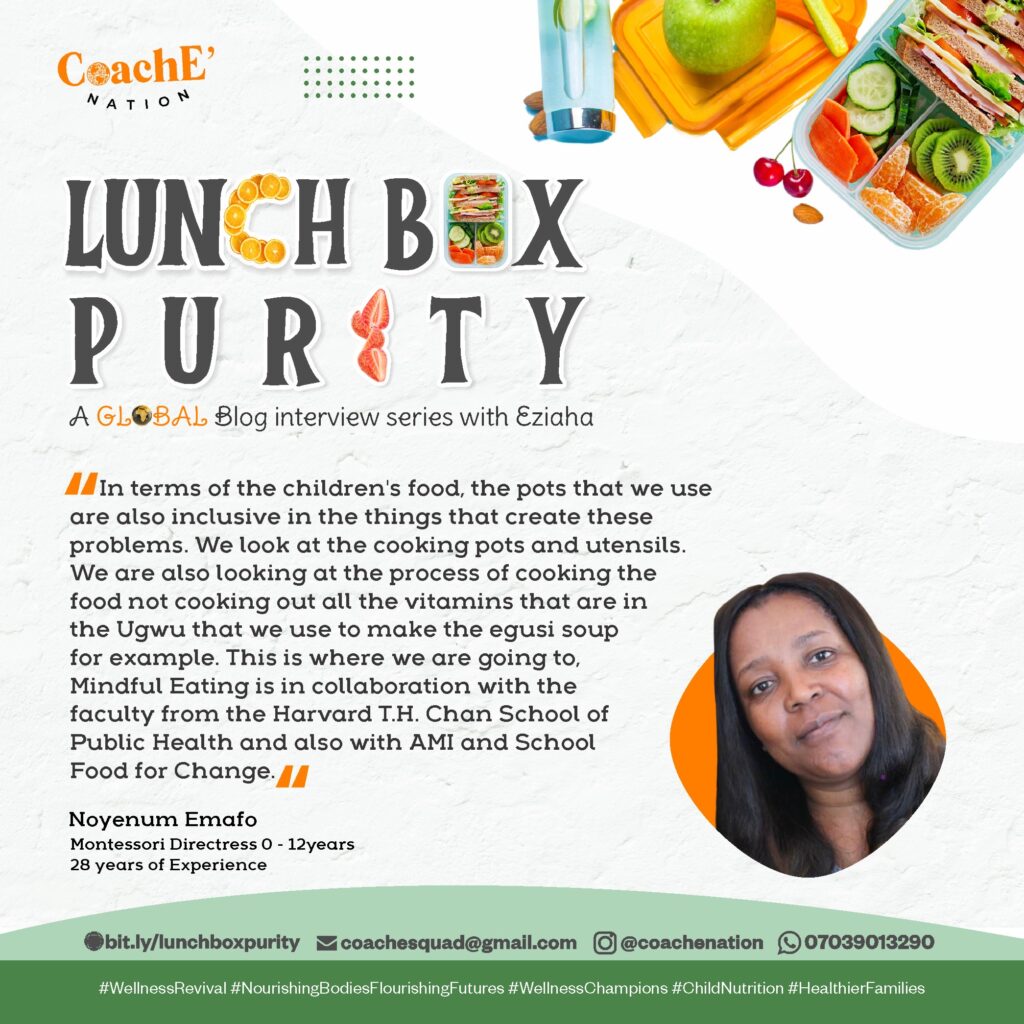
11. Are there resources or programs, whether locally or globally, you have found that have been particularly helpful in your efforts? If you don’t mind sharing, please share
Answer
The program that inspired me to start this was the Mindful Eating Challenge. It’s inspiring at least 400 young people to improve their eating habits so it’s not just about fruit and vegetables for snack time. This is just the beginning and this is how we want to launch the children into the main program. It also encourages school meals as opposed to children bringing their food from home. It’s not something that a lot of parents will buy into, especially children with specific dietary requirements but that’s where we want to go eventually so that we are also cooking the food in a healthy manner. In terms of the children’s food, the pots that we use are also inclusive in the things that create these problems. We look at the cooking pots and utensils. We are also looking at the process of cooking the food not cooking out all the vitamins that are in the Ugwu that we use to make the egusi soup for example. This is where we are going to, Mindful Eating is in collaboration with the faculty from the Harvard T.H. Chan School of Public Health and also with AMI and School Food for Change. These are three big organizations that have come together to look at it because we are trying to battle obesity and diabetes. These are all things that if the children have been taught to eat healthy from a very young age it would go a long way. Heart diseases as well and you know that in Africa we have high blood pressure at a very early age and it has to do specifically with our diets as well so there is a lot that we are going to look at and we hope to remain with this program and continue and advance in it as we are advised to.
Next week Monday, we are featuring our sixth Superstar Educator. They actually don’t get to answer the same set of Q’s so get excited about reading a wide array of Q and A’s!
And please support and spread the WORD that the LUNCH BOX PURITY blog series is LIVE!
You can create your own customized flier here and then share the link to the amazing Parents and Educators in your circle.
Ok, see you next Monday with our Super star Educator talking LUNCH BOX PURITY!
With all my HEALTHY Love!
Eziaha,
Wellness Revivalist and Lunch Box Purity
PS
Follow me on my brand new IG here after being away for over four years, and on LinkedIn here. My YouTube channels is value-choked and you can join that family here

